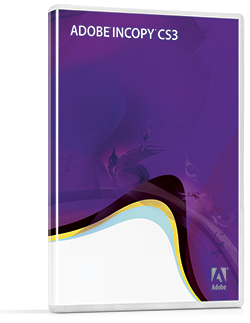InCopy CS3
Integrated text processing for InDesign
 InCopy CS3 is the Creative Suite’s text-processing tool, and its raison d’être is to provide systems integrators with a building block for publishing systems, such as those used by newspapers and magazines. It’s superbly designed for this high-end, professional role but out of the box and used as a front end for InDesign—in what Adobe calls its LiveEdit workflow—InCopy’s usefulness is more limited.
InCopy CS3 is the Creative Suite’s text-processing tool, and its raison d’être is to provide systems integrators with a building block for publishing systems, such as those used by newspapers and magazines. It’s superbly designed for this high-end, professional role but out of the box and used as a front end for InDesign—in what Adobe calls its LiveEdit workflow—InCopy’s usefulness is more limited.
Documents can be created from scratch using InCopy, but more likely they’ll originate from InDesign as an assignment. An assignment is a container file that bundles one or more components of an InDesign document—think of a newspaper article and its illustrations—that can be “checked out” of InDesign the way you’d check a book out of the library. An InDesign user creates a folder of assignments for an InDesign document or template for use by InCopy users. They, in turn, can write to fit the template or edit placed stories that have originated in, say, Microsoft Word. Any InCopy user can read an assignment, but only one at a time can check it out for editing.
InCopy shares most of InDesign’s typographic tools, so it can compose type just as InDesign does. This gives InCopy users three choices for viewing an assignment: as unformatted text; as galley type, with the same line endings created by InDesign; or as a placed document, in situ in an InDesign page. These last two options are ideal for copy-fitting—authors can write to fit using the same style sheets and typographic settings as InDesign. With the new table-setting style sheets in CS3, even typographic tyros can create complex tables ready for import into InDesign.
When designated as assignments, the stories in an InDesign document appear in the program’s Assignments panel. Here the InDesign user can see the status of each component of the open document, including who’s editing it. After an assignment has been checked back in, the InDesign user can review any changes and accept or reject them. Clearly, this works best on a network, where assignment folders appear like any others in an application’s file browser. In a clever addition to InCopy CS3, an assignment can be emailed to a collaborator who’s outside the network. When emailed back, it can be checked back into the InDesign document.
The problem with the LiveEdit workflow is that the Assignments panel is only accessible through InDesign. A managing editor who wants to see the status of the pieces in, say, a magazine issue, can only do that by opening it in InDesign. But in all likelihood, that file is being worked on by layout artists. Only one person can open an InDesign document at one time, so if the managing editor wants to see what’s going on in an issue, the layout artist has to close it first. This is only practical where the designer is also the project manager.
Adobe recommends LiveEdit only for small workgroups of 2 to 12; but it’s not the number that’s crucial, it’s how the workflow is organized, and having a designer act as a managing editor isn’t always realistic.—James Felici
PRICE: $249 (Upgrade $89)
FROM: Adobe Systems
WEB: www.adobe.com
RATING: 4
LAYERS VERDICT
HOT Key element for high-end systems integrators
NOT Limited utility for small workgroups
